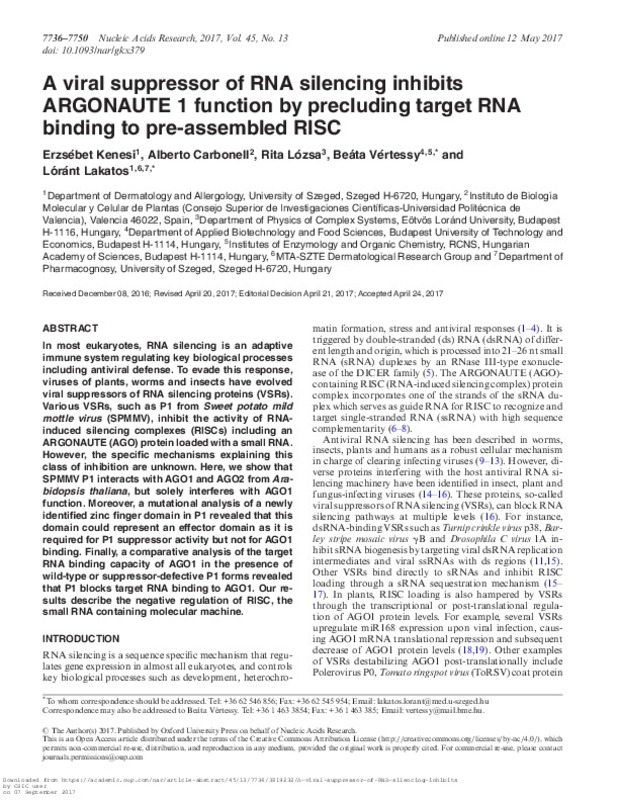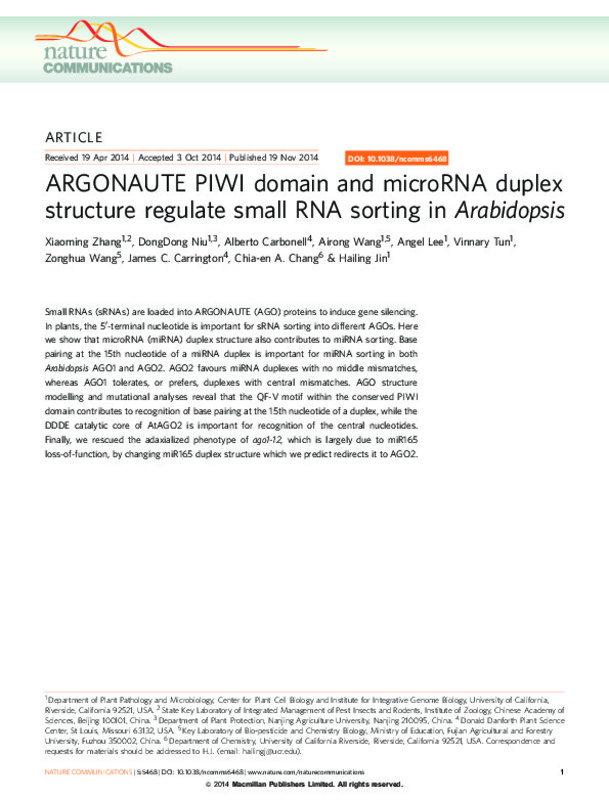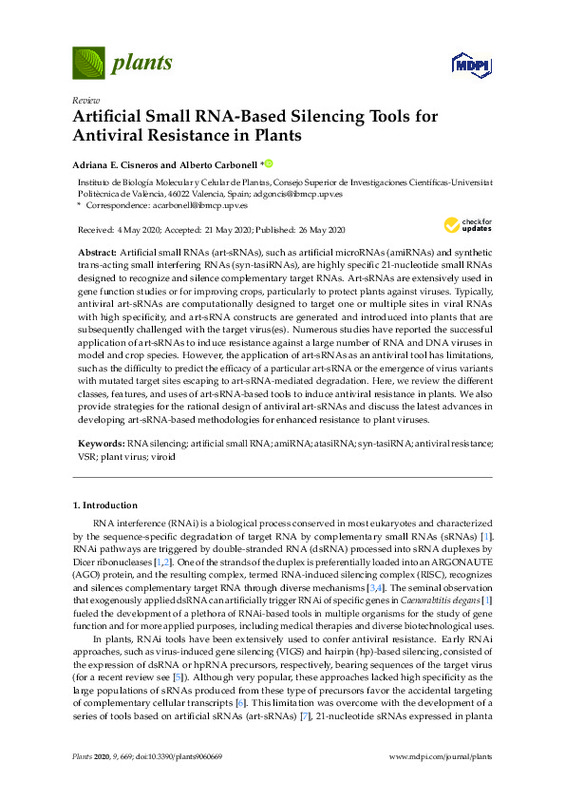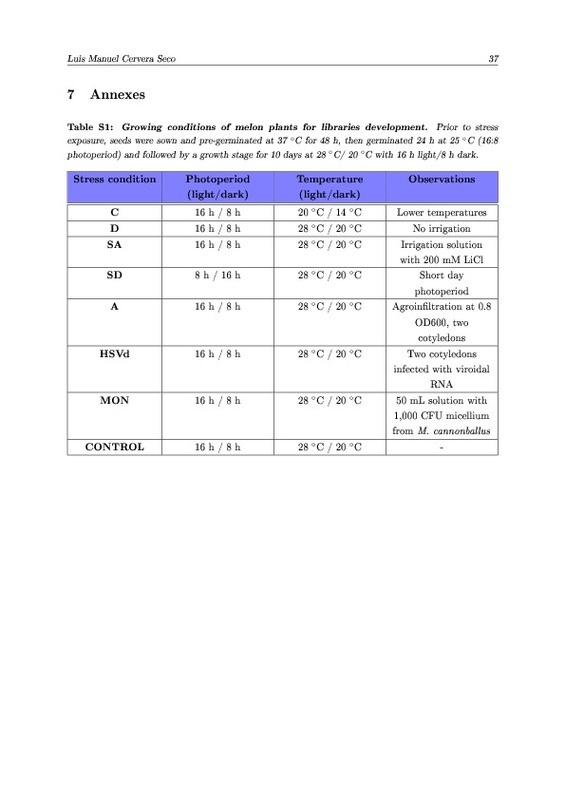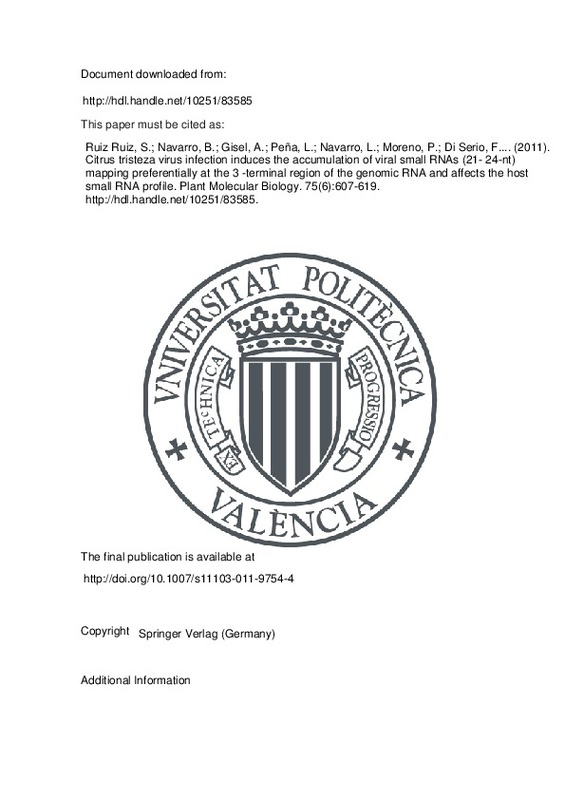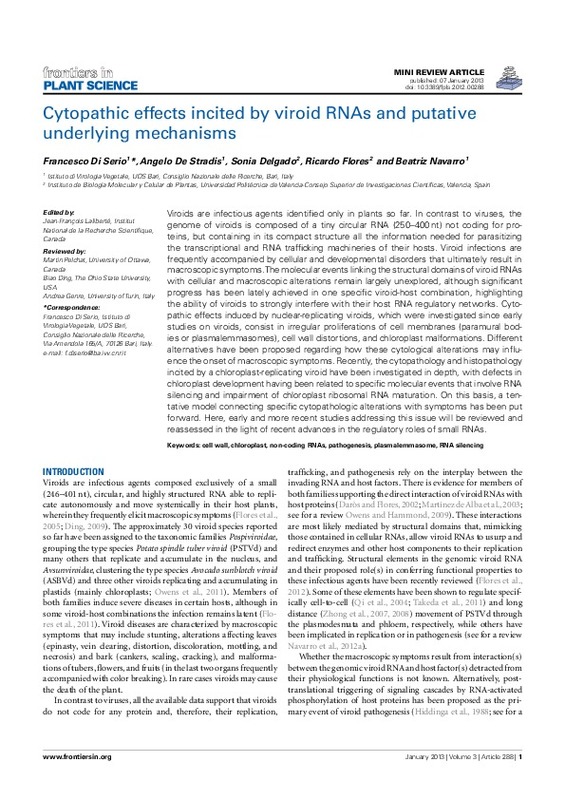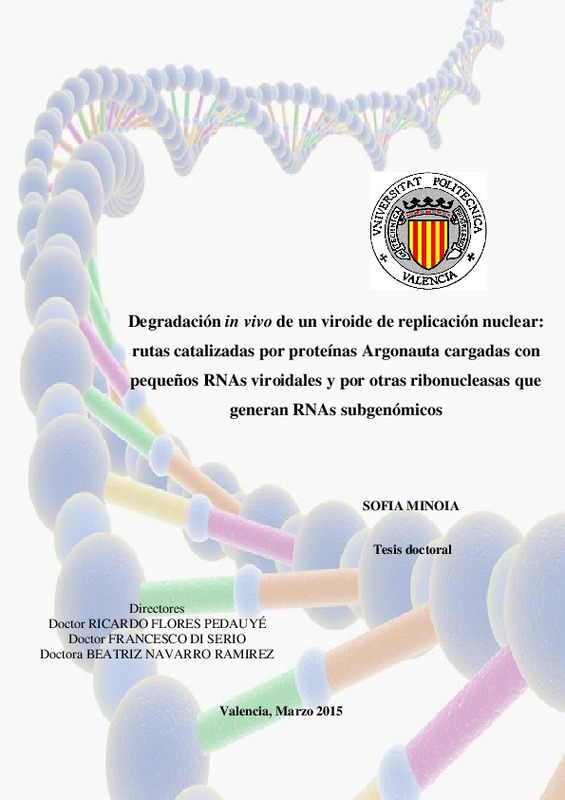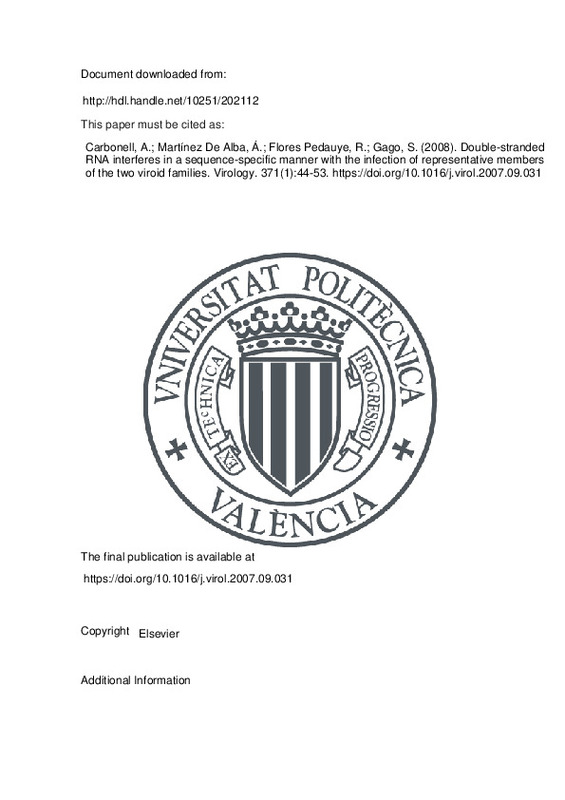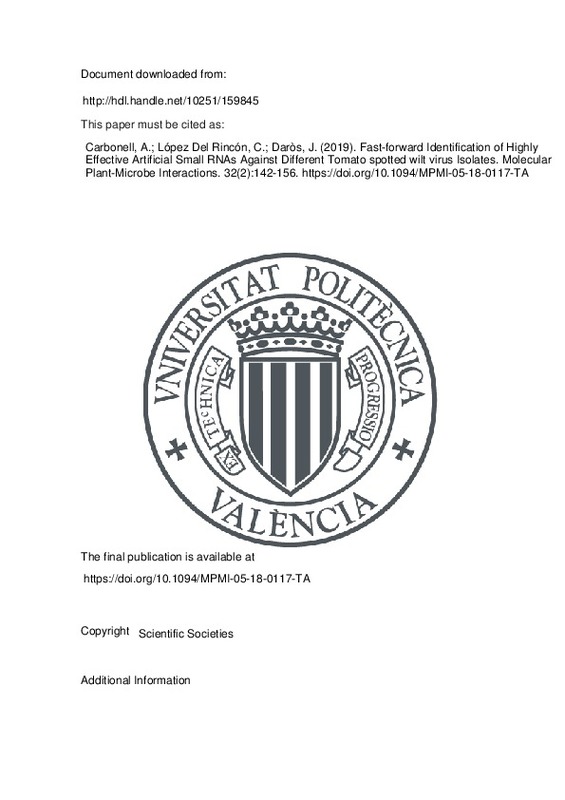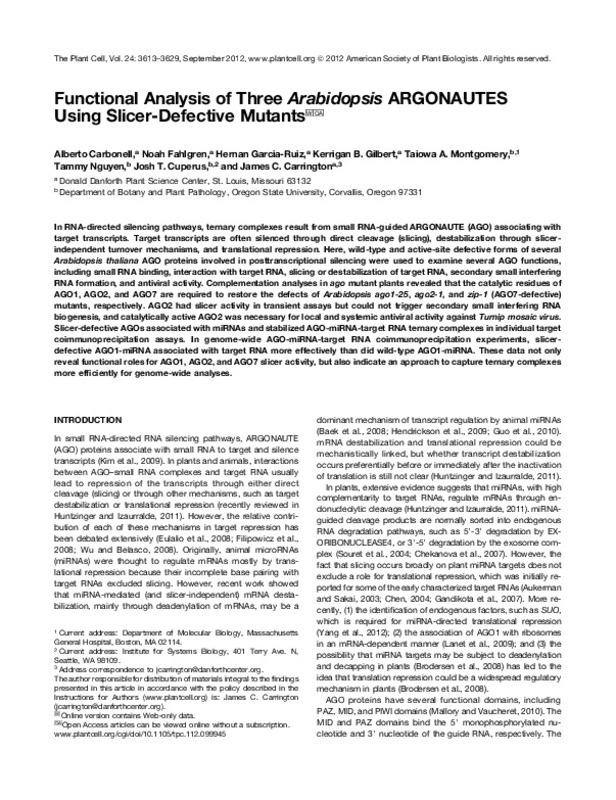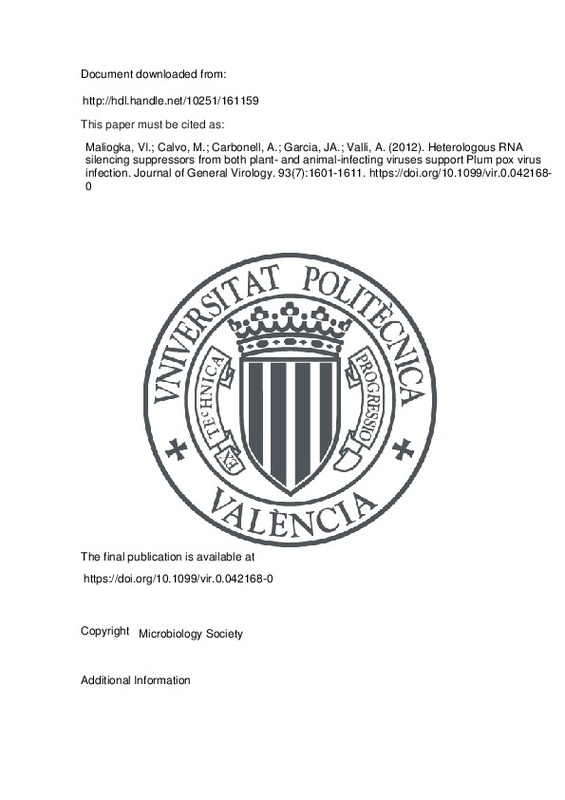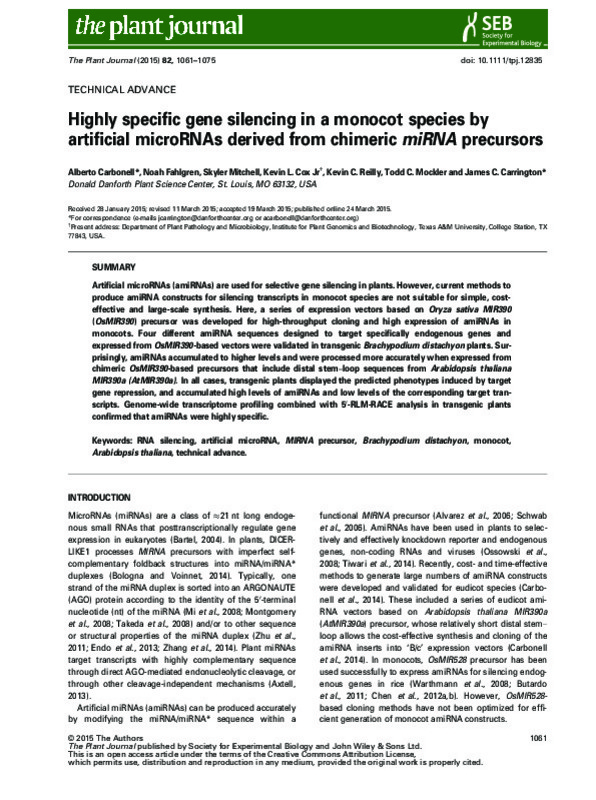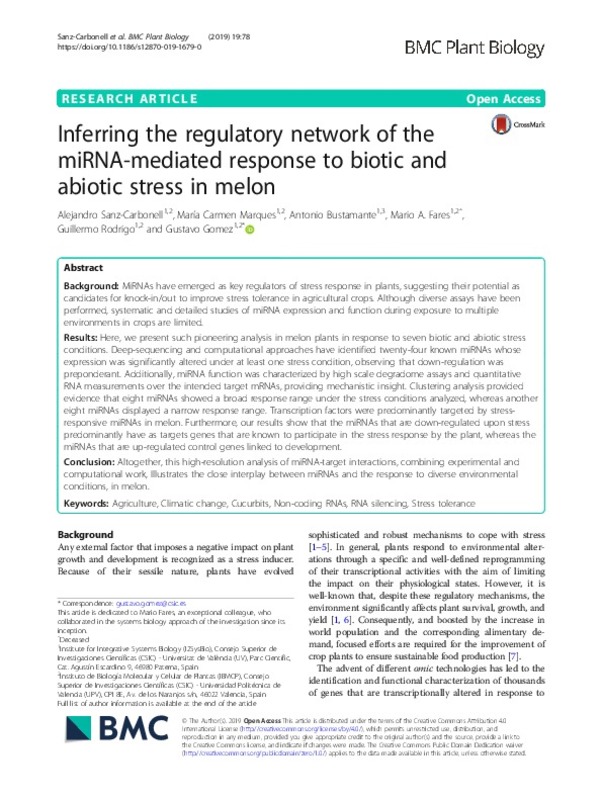

Listar por palabra clave "RNA silencing"
RiuNet: Repositorio Institucional de la Universidad Politécnica de Valencia
- RiuNet repositorio UPV
- :
- Listar por palabra clave
JavaScript is disabled for your browser. Some features of this site may not work without it.
Buscar en RiuNet
Listar
Mi cuenta
Ayuda RiuNet
Admin. UPV
Listar por palabra clave "RNA silencing"
Mostrando ítems 1-20 de 34
-
Kenesi, Erzsebet; CARBONELL, ALBERTO; Lozsa, Rita; Vertessy, Beata; Lakatos, Lorant (Oxford University Press, 2017-07-27)[EN] In most eukaryotes, RNA silencing is an adaptive immune system regulating key biological processes including antiviral defense. To evade this response, viruses of plants, worms and insects have evolved viral suppressors ...
-
Zhang, Xiaoming; Niu, DongDong; CARBONELL, ALBERTO; Wang, Airong; Lee, Angel; Tun, Vinnary; Wang, Zonghua; Carrington, James C.; Chang, Chia-en A.; Jin, Hailing (Nature Publishing Group, 2014-11-16)[EN] Small RNAs (sRNAs) are loaded into ARGONAUTE (AGO) proteins to induce gene silencing. In plants, the 5¿-terminal nucleotide is important for sRNA sorting into different AGOs. Here we show that microRNA (miRNA) duplex ...
-
Carbonell Olivares, Alberto; Daros Arnau, Jose Antonio (Wiley, 2016)[EN] Artificial microRNAs (amiRNAs) and synthetic trans-acting small interfering RNAs (syn-tasiRNAs) are two classes of artificial small RNAs (sRNAs) engineered to silence endogenous transcripts as well as viral RNAs ...
-
Cisneros, Adriana E.; CARBONELL, ALBERTO (MDPI, 2020-06)[EN] Artificial small RNAs (art-sRNAs), such as artificial microRNAs (amiRNAs) and synthetic trans-acting small interfering RNAs (syn-tasiRNAs), are highly specific 21-nucleotide small RNAs designed to recognize and silence ...
-
Cervera Seco, Luis Manuel (Universitat Politècnica de València, 2018-09-18)[ES] Los trans-acting siRNAs (ta-siRNAs) son una clase de pequeños RNAs (20 a 24 nts) reguladores descritos en plantas. Se producen a partir de regiones especí cas del genoma llamadas genes TAS. Los transcritos derivados ...
-
Ruiz Ruiz, Susana; Navarro, Beatriz; Gisel, Andreas; Peña, Leandro; Navarro, Luis; Moreno, Pedro; Di Serio, Francesco; Flores Pedauye, Ricardo (Springer Verlag (Germany), 2011-04)[EN] To get an insight into the host RNA silencing defense induced by Citrus tristeza virus (CTV) and into the counter defensive reaction mediated by its three silencing suppressors (p25, p20 and p23), we have examined by ...
-
Ruiz-Ruiz, Susana; Navarro, Beatriz; PEÑA GARCIA, LEANDRO; Navarro, Luis; Moreno, Pedro; Di Serio, Francesco; FLORES PEDAUYE, RICARDO (Springer, 2019)[EN] To dissect the host RNA silencing response incited by citrus tristeza virus (CTV, genus Closterovirus), a (+) ssRNA of similar to 19300 nt, and the counter reaction deployed by the virus via its three RNA silencing ...
-
Di Serio, Francesco; De Stradis, Angelo; Delgado Villar, Sonia Guadalupe; Flores Pedauye, Ricardo; Navarro, Beatriz (Frontiers Media, 2013-01-07)[EN] Viroids are infectious agents identified only in plants so far. In contrast to viruses, the genome of viroids is composed of a tiny circular RNA (250-400 nt) not coding for proteins, but containing in its compact ...
-
Minoia, Sofia (Universitat Politècnica de València, 2015-03-31)Los viroides, los agentes infecciosos más simples de la escala biológica, están constituidos por una molécula circular de RNA monocatenario de aproximadamente 250-400 nucleótios (nt) que no codifica proteína alguna. A ...
-
CARBONELL, ALBERTO; Martínez de Alba, Ángel-Emilio; FLORES PEDAUYE, RICARDO; Gago, Selma (Elsevier, 2008-02-05)[EN] Infection by viroids, non-protein-coding circular RNAs, occurs with the accumulation of 21¿24 nt viroid-derived small RNAs (vd-sRNAs) with characteristic properties of small interfering RNAs (siRNAs) associated to RNA ...
-
Puértolas García, Victoria (Universitat Politècnica de València, 2022-03-30)[ES] En plantas, una de las respuestas antivirales más eficientes está basada en el proceso de silenciamiento por RNA que es disparado por RNAs de doble cadena virales y que, en última instancia, conduce a la degradación ...
-
Carbonell, Alberto; López Del Rincón, Carmelo; Daròs, José-Antonio (Scientific Societies, 2019-02)[EN] Artificial small RNAs (sRNAs), including artificial microRNAs (amiRNAs) and synthetic trans-acting small interfering RNAs (syn-tasiRNAs), are used to silence viral RNAs and confer antiviral resistance in plants. ...
-
CARBONELL, ALBERTO; Fahlgren, Noah; García-Ruíz, Hernan; Gilbert, Kerrigan B.; Montgomery, Taiowa A.; Nguyen, Tammy; Cuperus, Josh T.; Carrington, James C. (American Society of Plant Biologists, 2012-09)[EN] In RNA-directed silencing pathways, ternary complexes result from small RNA-guided ARGONAUTE (AGO) associating with target transcripts. Target transcripts are often silenced through direct cleavage (slicing), ...
-
Maliogka, Varvara I.; Calvo, Maria; CARBONELL, ALBERTO; Garcia, Juan Antonio; Valli, Adrian (Microbiology Society, 2012-07)[EN] HCPro, the RNA silencing suppressor (RSS) of viruses belonging to the Potyvirus genus in the Potyviridae family, is a multifunctional protein presumably involved in all essential steps of the viral infection cycle. ...
-
CARBONELL, ALBERTO; Fahlgren, Noah; Mitchell, Skyler; Cox, Kevin L., Jr.; Reilly, Kevin C.; Mockler, Todd C.; Carrington, James C. (Blackwell Publishing, 2015-06)[EN] Artificial microRNAs (amiRNAs) are used for selective gene silencing in plants. However, current methods to produce amiRNA constructs for silencing transcripts in monocot species are not suitable for simple, cost-effective ...
-
Delgado Villar, Sonia Guadalupe; Navarro, Beatriz; Serra, Pedro; Gentit, Pascal; Cambra, Miguel Ángel; Chiumenti, Michela; De Stradis, Angelo; Di Serio, Francesco; FLORES PEDAUYE, RICARDO (Landes Bioscience, 2019-07-03)[EN] Understanding how viruses and subviral agents initiate disease is central to plant pathology. Whether RNA silencing mediates the primary lesion triggered by viroids (small non-protein-coding RNAs), or just intermediate-late ...
-
Cervera-Seco, Luis; Marques, M.C.; Sanz-Carbonell, Alejandro; Márquez-Molins, Joan; CARBONELL, ALBERTO; DAROS ARNAU, JOSE ANTONIO; Gomez, Gustavo Germán (Oxford University Press, 2019-11)[EN] Small interfering RNAs (siRNA) are key regulators of gene expression that play essential roles in diverse biological processes. Trans-acting siRNAs (tasiRNAs) are a class of plant-endogenous siRNAs that lead the ...
-
Pallás Benet, Vicente; HERNANDEZ FORT, CARMEN; Marcos, Jose F.; Daròs, José-Antonio; Ambrós, Silvia; Navarro, Beatriz; NAVARRO BOHIGUES, JOSE ANTONIO; La Peña Del Rivero, Marcos De; Gago-Zachert, Selma; Gas, Maria E.; CARBONELL, ALBERTO; López Del Rincón, Carmelo; Martínez-De Alba, Angel E.; Di Serio, Francesco; Moreno, Pedro (Elsevier, 2022-04-15)[EN] Ricardo Flores (1947-2020) focused his research on the identification, replication, pathogenesis, and evolution of viroids, the minimal non-protein-coding circular RNAs (250-400 nt) able to replicate and incite diseases ...
-
Sanz-Carbonell, Alejandro; Marques Romero, Mª Carmen; Bustamante-González, Antonio Javier; Fares Riaño, Mario Ali; Rodrigo Tarrega, Guillermo; Gomez, Gustavo Germán (Springer (Biomed Central Ltd.), 2019-02-18)[EN] Background: MiRNAs have emerged as key regulators of stress response in plants, suggesting their potential as candidates for knock-in/out to improve stress tolerance in agricultural crops. Although diverse assays have ...
-
Soler, Nuria; Plomer, Montserrat; Fagoaga, Carmen; Moreno, Pedro; Navarro, Luis; FLORES PEDAUYE, RICARDO; Peña, Leandro (Springer, 2019)[EN] Conventional breeding of citrus types demands a long-term effort due to their complex reproductive biology and long juvenile period. As a compelling alternative, genetic engineering of mature tissues allows the insertion ...
Mostrando ítems 1-20 de 34

Universitat Politècnica de València. Unidad de Documentación Científica de la Biblioteca (+34) 96 387 70 85 · RiuNet@bib.upv.es


